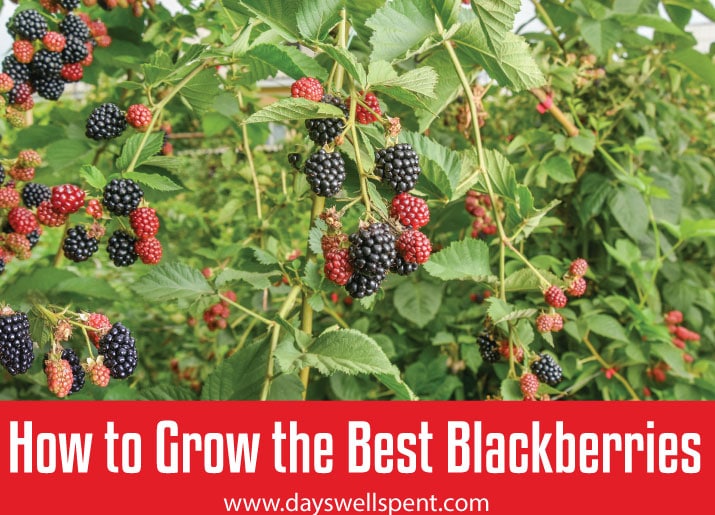
Do you love plucking ripe blackberries from those wild, rambling bushes you see along roadsides and wooded edges? Have you ever thought about growing blackberries in your garden? You can grow your own tasty berries right in the backyard with our simple tips.
WHEN TO PLANT
Where you live will influence when you plant. In Texas, blackberries should be planted in the fall. However, in areas with early winter and more mild summers, blackberries can be planted in the early spring. Regardless of when you plant, they should be spaced about 3′-4′ between plants and 8′-12′ between rows.
WHERE TO PLANT
Before you start digging a hole, you need to find the right spot for them. Most blackberry bushes do best in full sunshine, but they can tolerate some shade. If placed in too much shade, they will not produce fruit. If at all possible, do plant them near tomatoes, peppers, eggplants, or strawberries because they are prone to similar bugs. Ours are planted about 3′ from our tomatoes, and that appears to be working out so far.
SOIL
Blackberries grow best in deep sandy soil, but any well-drained soil will work if the pH ranges from 4.5 to 7.5. If your soil does not drain well, try growing the berries in raised beds.
WATER
Rainfall or irrigation is needed every 7 to 10 days, depending on how well your soil holds moisture. Many people use drip irrigation, and it is probably the best system for blackberries as the plants like lots of moisture but do not like to be too wet. We only use the water from our rain barrels for the blackberry bushes.
MULCH
If you’ve read many of my posts, you know I mulch everything! Blackberries are not different. We use the large bark chips since the plants will remain in the same location each year. Our blackberry bushes have about 5″ of mulch around them.
FEEDING
A balanced fertilizer should be used in the first year after the plants show new growth. The following years only nitrogen is usually needed. You can apply the fertilizer as a narrow band along the row. If you can, get a soil test to determine your exact soil requirements.
VARIETIES
Thorned Varieties
All these erect thorned varieties have ‘Brazos’ in their heritage. It was developed here in Texas and has been the standard for blackberry production in Texas for years. The most popular and well suited to Texas soil are Brazos, Rosborough, Womack, Cheyenne, Chickasaw, Choctaw, Brison, Shawnee, Kiowa.
Thornless Varieties
These erect thornless varieties can all trace their heritage back to the varieties ‘Merton Thornless’ from England and ‘Thornfree’ from the USDA breeding program. All are patented releases of the University of Arkansas breeding program. When choosing our bushes, we went with the thornless varieties for obvious reasons.
The most popular and well-suited Texas soil thornless varieties are Apache, Arapaho, Navaho, Ouachita, Natchez. Many of these can be purchased at local nurseries or online on Amazon. We have bought several different plants from Amazon with outstanding results. It’s a great way to find varieties that local nurseries may not carry.
CONTAINER OR IN-GROUND
We have not tried growing blackberries in containers yet, but it can be done. Just make sure you purchase a bush variety intended for container gardening.
POLLINATING
Some varieties are self-pollinating, but for best results, two or more bushes are recommended. Our bees do an amazing job at pollinating our bushes. If you don’t have bees, never fear, bees, butterflies, and many other types of pollinators will find your bushes.
WHEN WILL I GET FRUIT
Blackberries are perennial plants that grow canes in two-year cycles. The first year the new canes grow but do not produce any flowers. In the second year, the same canes do not grow; instead, they have flowering laterals with small leaves. The white-to-pale pink flowers are produced on the tips of the flowering laterals. The fruit is actually a collection of numerous drupelets which form the “berry.” Each year you can expect the harvest will increase.
HARVESTING
You will not be able to harvest any berries your first year. Depending on the variety and climate, berries will be ready to pick mid-May-August. Our bushes are harvested from mid-May-late July. We still have a few in Early August, but it’s not enough to really do anything with other than enjoy as a quick snack.
Blackberries are ready for harvest when the blackberry has changed to the deep purple/black color. The longer the berry remains on the bush the sweeter it will get. When you go to pick it, if it is ready, it will give freely. If you have to pull hard on it it’s not ready.
PRUNING
After you have harvested all the blackberries from your plant, you will need to prune off the canes that produced fruit, because they will not fruit again. Removing the floricanes needs to be done with both erect and trellising blackberry types. For trellising plants, you will need to remove all but the strongest six to 12 canes, which will produce fruit the following year. Train the remaining canes of trellising blackberry plants up to a trellis so they will be properly supported for the next growing season.
That’s all there is to it! Once in the ground taking care of the blackberry bushes is pretty simple. The plants will continue to produce berries for 15-20 years.